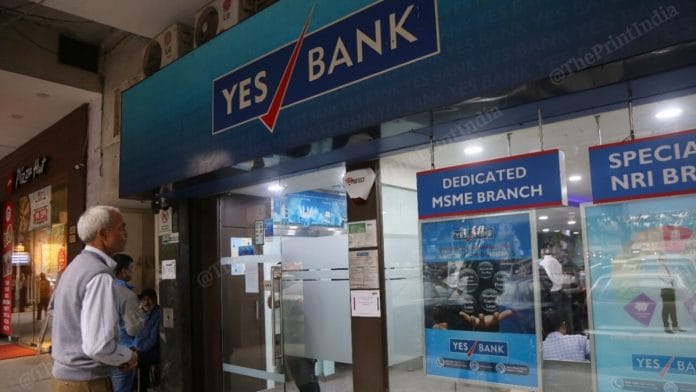Mumbai: India’s decision to seize control of its fourth-largest private bank at a time when the coronavirus is roiling markets risks prolonging a credit crunch among the nation’s non-traditional financiers.
The Yes Bank Ltd. takeover last week marked the first instance of a large bank falling prey to contagion from the shadow-lender crisis that policy makers have struggled to contain for 18 months.
Yes Bank’s collapse now threatens to sharpen the division between the weak and strong in India’s financial system — many are cash-starved while a healthy few raise money at rates predating the onset of the crisis. The fresh shock to funding markets will extend the struggle of second- and third-tier institutions and delay a lending recovery that’s badly needed as economic growth slumps toward an 11-year low. At their height, shadow banks accounted for about a third of new loans sanctioned.
“Some of the large shadow banks are back to lending,” said Madhavi Arora, an economist at Edelweiss Securities Ltd. in Mumbai. “However, it is a long way to go before the shadow banking sector revives and gets back to full-fledged lending.”
Yes Bank was brought down by its exposure to non-bank lenders and developers — both caught up in the funding crunch that’s persisted since late 2018. Confidence in the financial sector is “quite shaky,” said Arora.
Here are four charts showing the state of the shadow lending sector, which was a key source of credit for consumers and small businesses.
1. There’s no crisis for top-rated shadow banks
Spreads on AAA rated five-year shadow bank bonds have narrowed to 86 basis points, close to levels from September 2018 when defaults at Infrastructure Leasing & Financial Services Ltd. triggered the shadow banking crisis. The gap to sovereign paper closed this month as lower crude prices eased inflationary pressures and raised the prospect of a central bank rate cut.
Confidence in AA rated non-bank lenders is yet to fully recover though, with investors demanding a 169 basis point premium, about 39 basis points more than the pre-crisis average.
Spreads for both groups narrowed sharply in December after India allowed financial firms to be taken to the nation’s bankruptcy court, assuring market players that there was a mechanism in place for an orderly unwinding of troubled firms.
The Reserve Bank of India has reduced the number of financiers it is closely monitoring to three or four now from about 10 previously, Governor Shaktikanta Das said in a recent interview.
Also read: In Yes Bank crisis, you can’t miss the ugly realities of India’s private sector lenders
The Bloomberg check-up above of the sector’s health in February showed that:
- Banking system liquidity remained plentiful as the RBI undertook long-term repo operations to reduce borrowing rates.
- Spreads on top-rated bonds of shadow lenders rose in February, but have fallen slightly in March on rate cut expectation.
- Each indicator in the chart is assigned a value on a scale of 1 to 7, with 1 implying weakness and 7 showing strength.
2. The funding divide
Commercial paper and mutual fund money have dried up from many since the crisis began, and shadow lenders have been forced to rely more on regular bank funding. The financiers have a record redemption of 1.1 trillion rupees ($14.8 billion) of local-currency bonds coming up over the next three months.
Government efforts to encourage purchases of shadow bank loan books by guaranteeing some of the assets have had a limited impact, bankers say.
“Funds are flowing to shadow banks that are perceived to have low risk on asset quality” and a diversified asset book, said Anil Gupta, sector head of financial sector ratings at ICRA Ltd. “For others, funding will remain a challenge.”
3. The second-tier of shadow banks is retreating
Shadow banks accounting for about 15% of the sector’s total lending are shrinking their loan book, analysts led by Ashish Gupta wrote last month in a Credit Suisse Group AG report.
While government-backed and other healthy non-banks are growing loans by between 12% to 35% annually, the weaker ones are seeing a contraction of anywhere between 2% and 20%, Gupta said.
For example, Bajaj Finance Ltd., one of the most successful non-banks, grew its loan book 32% in 2019, while Piramal Enterprises Ltd.’s financial services arm, which has large exposure to the real estate sector, saw a 7% contraction.
4. Loan growth is sliding
Shadow banks have dramatically slowed loan growth from levels of about 20% each year prior to the crisis. Crisil Ltd., the local arm of S&P Global Ratings, expects a drop to only 6% to 8% in the year to March 2020.
The squeeze has fallen heavily on smaller Indian companies. Credit extended by shadow banks to medium-sized enterprises contracted by 34% in the 12 months to September, according to the RBI. –Bloomberg
Also read: For 9 yrs, Yes Bank board was led by ex-IAS officers, yet its lending grew unchecked







You mean Yogi and Amit Shah will advise the PM who is unlikely to listen anything he does not know or understand.?